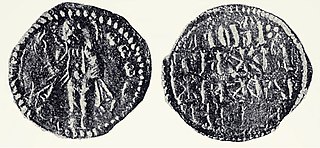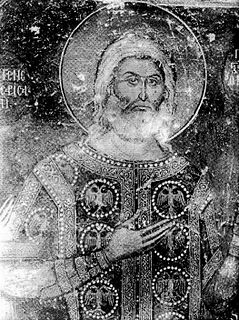 W
WAlexius Slav was a Bulgarian nobleman (bolyarin), a member of the Bulgarian Asen dynasty, a nephew of the first three Asen brothers. He was first probably the governor of the Rhodopes domain of the Second Bulgarian Empire, and then an autocrat in these lands.
 W
WKonstantin (Kostadin) Dejanović was a Serbian magnate that ruled a large province in eastern Macedonia under Ottoman suzerainty, during the fall of the Serbian Empire. He succeeded his older brother Jovan Dragaš, who had been an Ottoman vassal since the Battle of Maritsa (1371) which had devastated part of the Serbian nobility. The brothers had their own government and minted coins according to the Nemanjić style. His daughter Jelena married Byzantine Emperor Manuel II Palaiologos in 1392. He fell at the Battle of Rovine, serving the Ottomans against Wallachia, fighting alongside Serbian magnates Stefan Lazarević and Marko Mrnjavčević.
 W
WThe Gropa family was an Albanian noble family which ruled the region between Pogradec, Ohrid and Debar in the period 12th — 14th century.
 W
WAndrea Gropa was a 14th-century nobleman who ruled the region and the city of Ohrid, first as a minor vassal (župan) to Serbian King Vukašin Mrnjavčević, then as an Ottoman vassal after the Battle of Maritsa. He hailed from the noble Gropa family.
 W
WHrelja (Bulgarian: Хрельо, Hrelyo;, also known as Stefan Dragovol or Hrelja Ohmućević was a 14th-century semi-independent feudal lord in the region of northeastern Macedonia and the Rila mountains who served medieval Serbian kings Stefan Milutin, Stefan Dečanski and Stefan Dušan. He is known for reconstructing the Rila Monastery, Bulgaria's largest monastery, in 1334–1335.
 W
WNovak the Serb was a 14th-century Serbian nobleman that held the region of Lake Prespa during the Serbian Empire of Uroš the Weak. He held the title of Caesar, and is hence also known as Kesar Novak.
 W
WPaskač was a Serbian nobleman that served the Serbian Empire, with the title of knez. Together with his son, sevastokrator Vlatko, he founded the Psača Monastery, in which the ktetor fresco of his family has been preserved, painted between 1365 and 1371. He is depicted as an old man, grey-haired, holding the church model together with Vlatko in the centre. By Paskač is his wife, noblewoman Ozra, and also their grandson, Uglješa. The family is wearing rich clothing. Nothing else is known of Paskač; he is not mentioned in donation charters. His function in the state is unknown, and it is unknown in which capacity he received the title of knez. Mandić theorizes that if Paskač was a magnate, he would have succeeded Vojislav as the veliki knez, then Lazar could have received that title after Paskač's death, possibly during the Empire. The fresco composition is valued highly, and is, as other 14th-century works, part of several special studies.